1993 CADILLAC FLEETWOOD low beam
[x] Cancel search: low beamPage 112 of 386
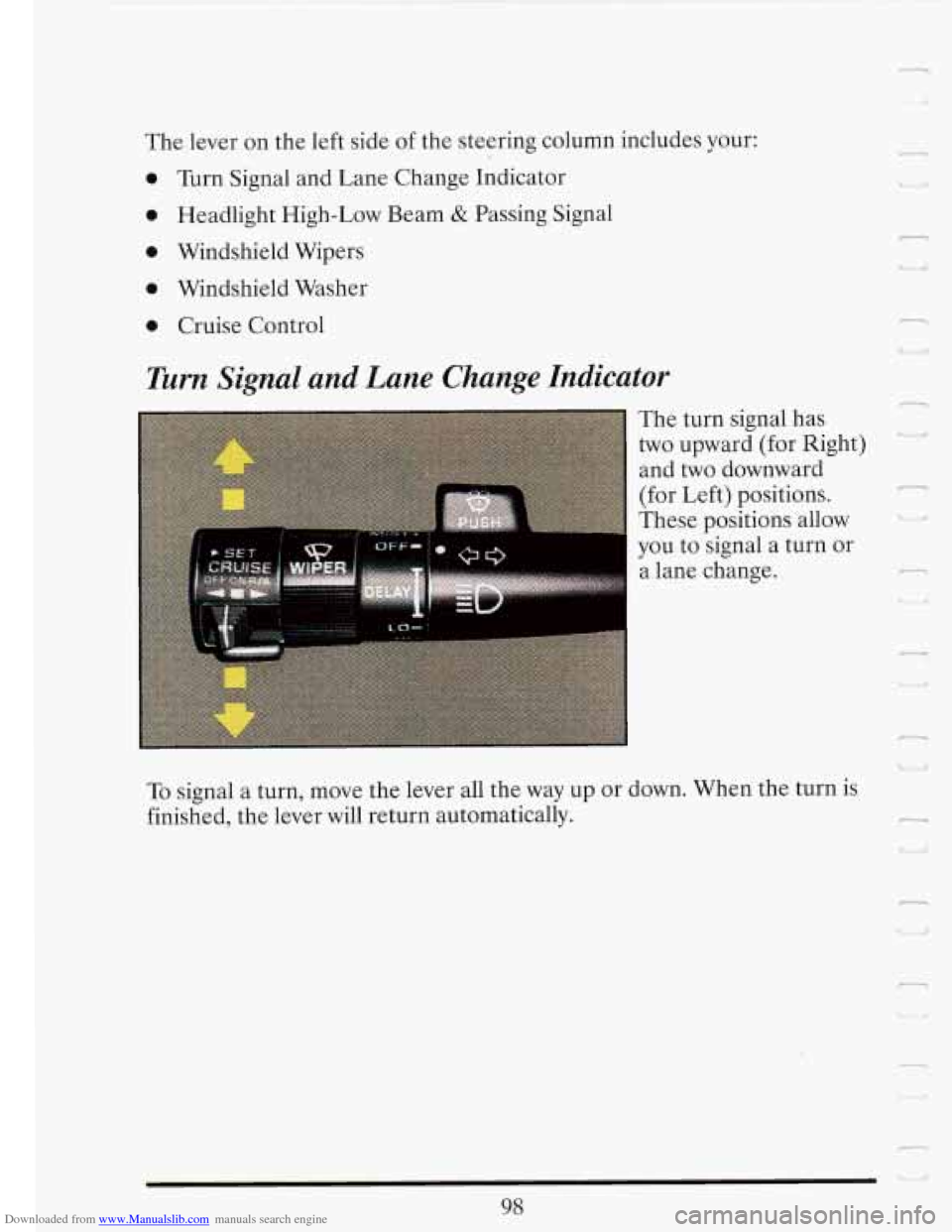
Downloaded from www.Manualslib.com manuals search engine The lever on the left side of the steering column includes your:
0 Turn Signal and Lane Change Indicator
0 Headlight High-Low Beam & Passing Signal
0 Windshield Wipers
0 Windshield Washer
0 Cruise Control
Turn Signal and Lane Change Indicator
The turn signal has
two upward (for Right)
and
two downward
(for Left) positions.
These positions allow
you to signal a turn or
a lane change.
To signal a turn, move the lever all the way up or down. When the turn is
finished, the lever will return automatically.
98
n
*-' I
n .
*
-
dl
n
-
e-
Page 114 of 386
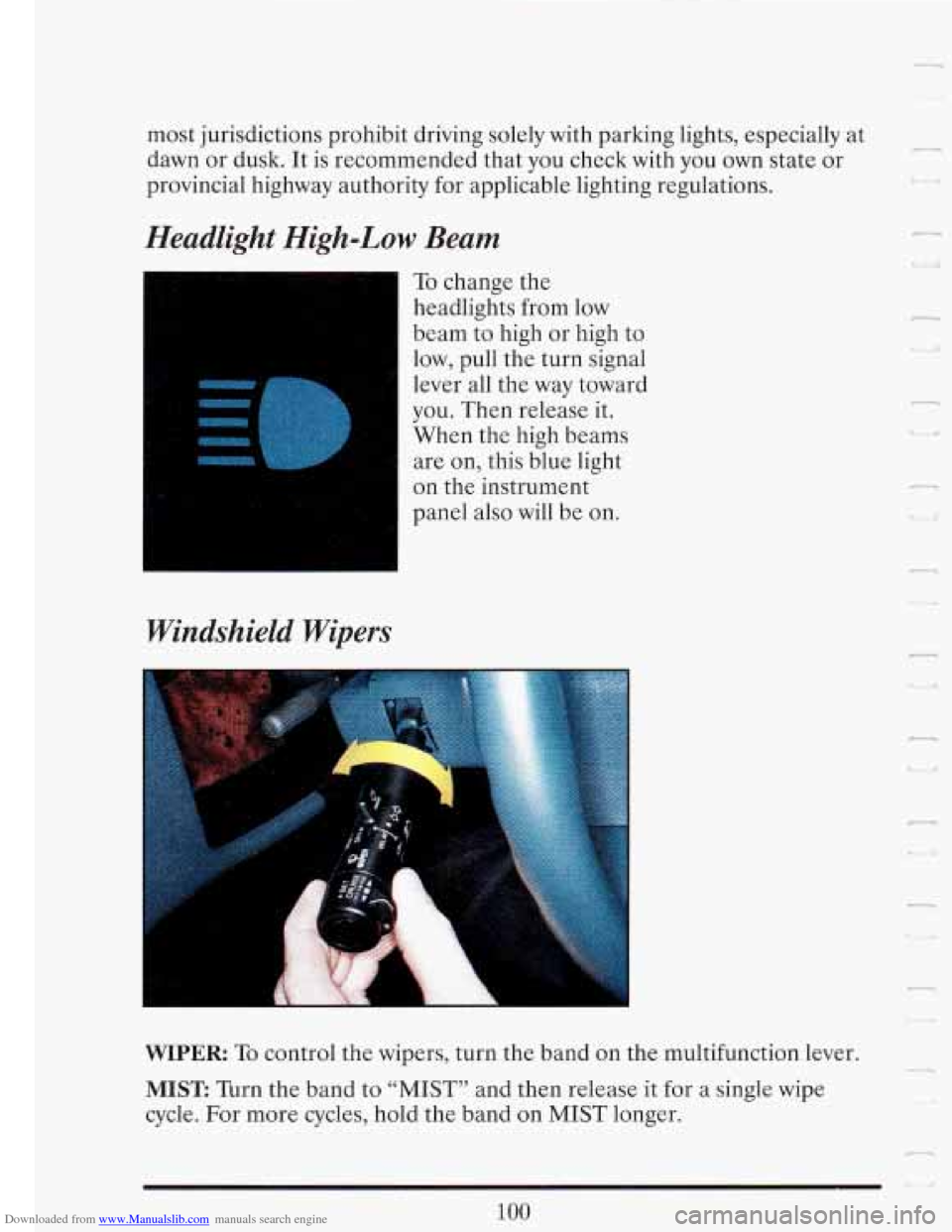
Downloaded from www.Manualslib.com manuals search engine most jurisdictions prohibit driving solely with parking lights, especially at
dawn or dusk. It is recommended that you check with
you own state or
provincial highway authority for applicable lighting regulations.
Headlight High-Low Beam
Windshield Wipers
To change the
headlights from low
beam to high or high to
low, pull the turn signal
lever all the way toward
you. Then release it.
When the high beams
are on, this blue light
on the instrument
panel also will be on.
WIPER To control the wipers, turn the band on the multifunction lever.
MIST: Turn the band to “MIST” and then release it for a single wipe
cycle. For more cycles, hold the band on MIST longer.
1 :I, U
100
Page 194 of 386
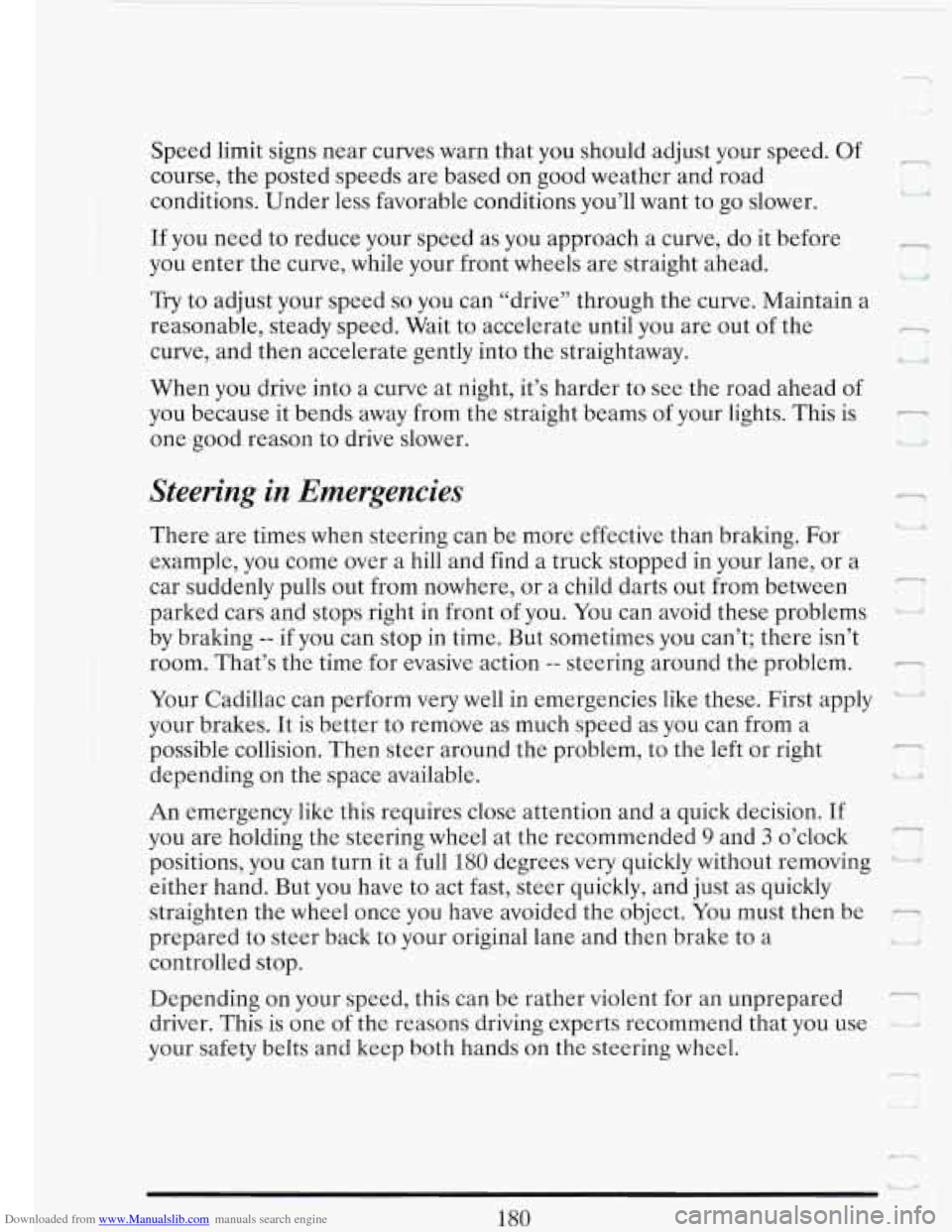
Downloaded from www.Manualslib.com manuals search engine c 1
Speed limit signs near curves warn that you should adjust your speed. Of
course, the posted speeds are based on good weather and road
conditions. Under less favorable conditions you’ll want to go slower.
If you need to reduce your speed as you approach a curve, do it before
you enter the curve, while your front wheels are straight ahead.
Try to adjust your speed so you can “drive” through the curve. Maintain a
reasonable, steady speed. Wait to accelerate until you are out of the
curve, and then accelerate gently into the straightaway.
When you drive into a curve at night, it’s harder to see the road ahead of
you because it bends away from the straight beams of your lights. This is
one good reason to drive slower.
n
cz;
n
Steering in Emergencies
There are times when steering can be more effective than braking. For
example, you come over a hill and find a truck stopped in your lane, or a
car suddenly pulls out from nowhere, or a child darts out from between
parked cars and stops right in front
of you. You can avoid these problems
by braking
-- if you can stop in time. But sometimes you can’t; there isn’t
room. That’s the time for evasive action
-- steering around the problem. -
-
Your Cadillac can perform very well in emergencies like these. First apply
your brakes. It is better to remove as much speed as you can from a
possible collision. Then steer around the problem, to the left or right
depending on the space available. I,
An emergency like this requires close attention and a quick decision. If
you are holding the steering wheel at the recommended
9 and 3 o’clock
positions, you can turn it a full
180 degrees very quickly without removing ‘ i’
either hand. But you have to act fast, steer quickly, and just as quickly
straighten the wheel once you have avoided the object. You must then be
-
7
prepared to steer back to your original lane and then brake to a
controlled stop.
Depending on your speed, this can be rather violent for an unprepared
driver. This is one of the reasons driving experts recommend that you use
your safety belts and keep both hands
on the steering wheel.
-1
r P
180
Page 200 of 386
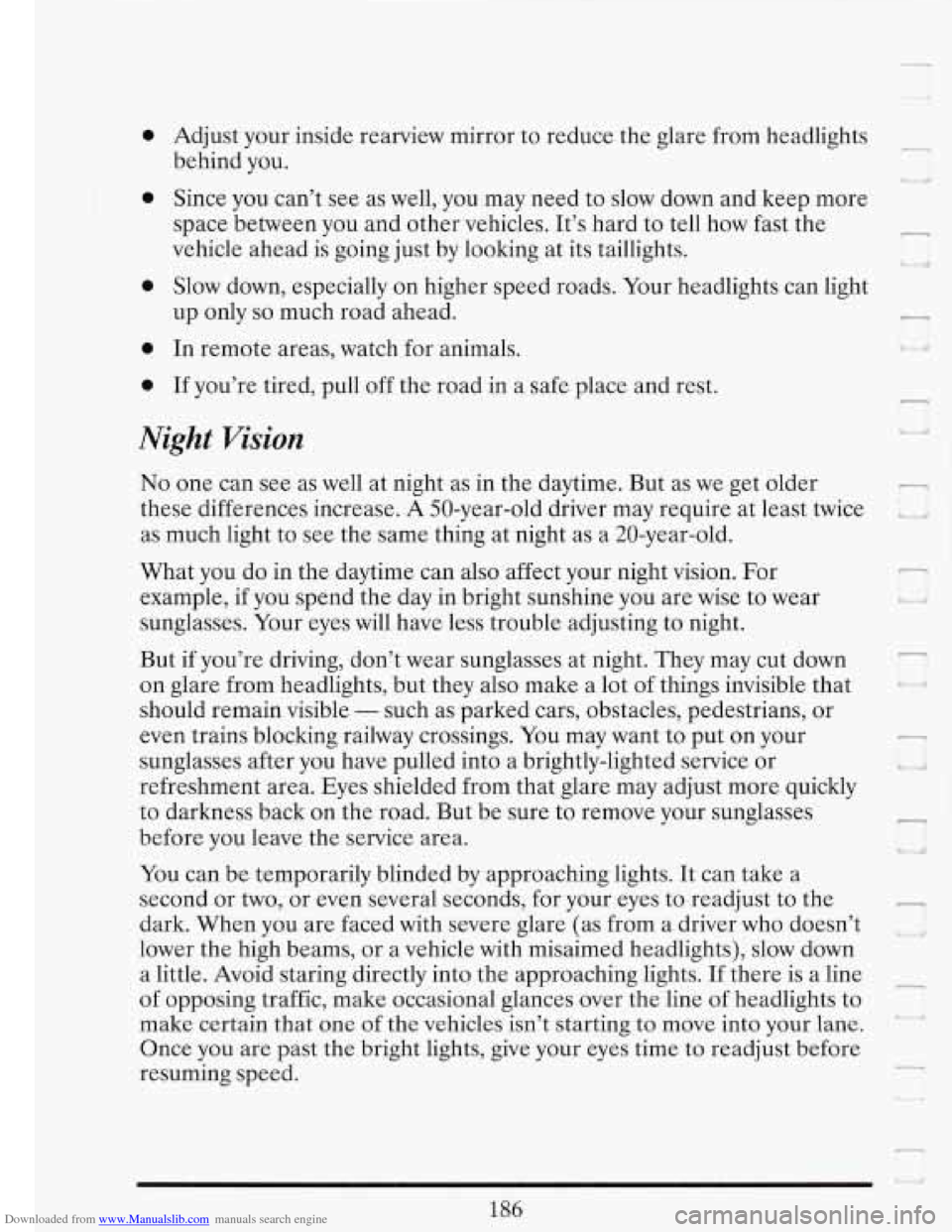
Downloaded from www.Manualslib.com manuals search engine 0
0
0
0
0
Adjust your inside rearview mirror to reduce the glare from headlights
behind you. -
Since you can’t see as well, you may need to slow down and keep more
space between you and other vehicles. It’s hard to tell how fast the
vehicle ahead is going just by looking at its taillights.
Slow down, especially on higher speed roads. Your headlights can light
up only
so much road ahead.
In remote areas, watch for animals.
If you’re tired, pull off the road in a safe place and rest.
Night Vision
f-I
i
No one can see as well at night as in the daytime. But as we get older -
these differences increase. A 50-year-old driver may require at least twice i,
as much light to see the same thing at night as a 20-year-old.
What you do in the daytime can also affect your night vision. For
example, if you spend the day in bright sunshine you are wise to wear
sunglasses. Your eyes will have less trouble adjusting to night.
But if you’re driving, don’t wear sunglasses at night. They may cut down
on glare from headlights, but they also make a lot of things invisible that
should remain visible
- such as parked cars, obstacles, pedestrians, or
even trains blocking railway crossings.
You may want to put on your
sunglasses after you have pulled into a brightly-lighted service or
refreshment area. Eyes shielded from that glare may adjust more quickly
to darkness back on the road. But be sure to remove your sunglasses
before you leave the service area.
I
3:
You can be temporarily blinded by approaching lights. It can take a
second or
two, or even several seconds, for your eyes to readjust to the r
dark. When you are faced with severe glare (as from a driver who doesn’t
lower the high beams, or a vehicle with misaimed headlights), slow down
a little. Avoid staring directly into the approaching lights.
If there is a line
of opposing traffic, make occasional glances over the line of headlights to
make certain that one of the vehicles isn’t starting to move into your lane.
Once you are past the bright lights, give your eyes time to readjust before
resuming speed.
I.-
-
i*
It 81
186
Page 201 of 386
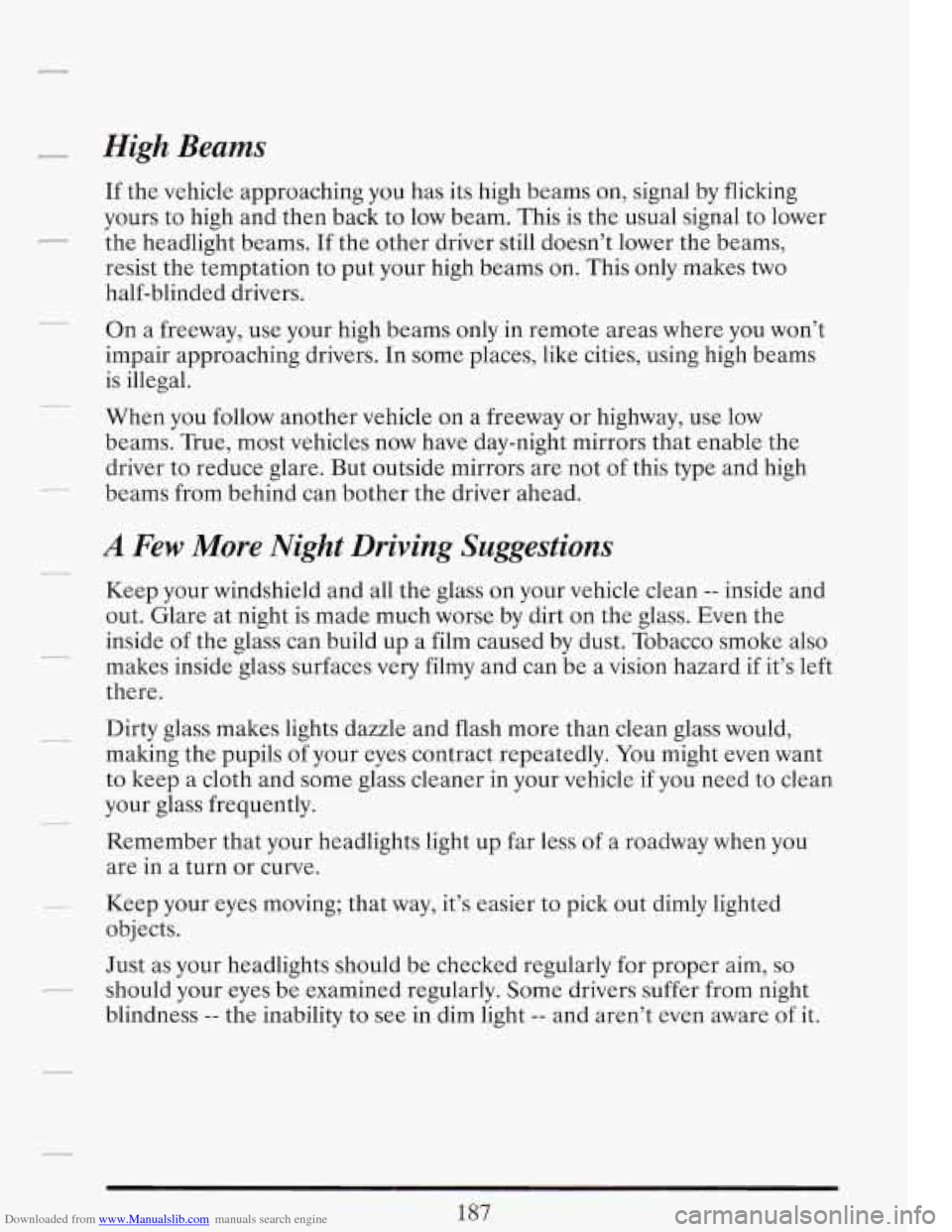
Downloaded from www.Manualslib.com manuals search engine r High Beams
If the vehicle approaching you has its high beams on, signal by flicking
yours to high and then back to low beam. This is the usual signal to lower
the headlight beams.
If the other driver still doesn’t lower the beams,
resist the temptation to put your high beams on. This only
makes two
half-blinded drivers.
- On a freeway, use your high beams only in remote areas where you won’t
impair approaching drivers. In some places, like cities, using high beams
is illegal.
When you follow another vehicle on a freeway or highway, use low
beams. True, most vehicles now have day-night mirrors that enable the
driver to reduce glare. But outside mirrors are not of this type and high
beams from behind can bother the driver ahead.
-
-
A Few More Night Driving Suggestions
-
Keep your windshield and all the glass on your vehicle clean -- inside and
out. Glare at night is made much worse by dirt on the glass. Even the
inside
of the glass can build up a film caused by dust. Tobacco smoke also
makes inside glass surfaces very filmy and can be a vision hazard
if it’s left
there. -
~ Dirty glass makes lights dazzle and flash more than clean glass would,
making the pupils
of your eyes contract repeatedly. You might even want
to keep a cloth and some glass cleaner in your vehicle if you need to clean
your glass frequently.
Remember that your headlights light up far less
of a roadway when you
are in a turn or curve.
-
_- Keep your eyes moving; that way, it’s easier to pick out dimly lighted
objects.
Just as your headlights should be checked regularly for proper aim, so
blindness
-- the inability to see in dim light -- and aren’t even aware of it.
- should your eyes be examined regularly. Some drivers suffer from night
187
Page 239 of 386
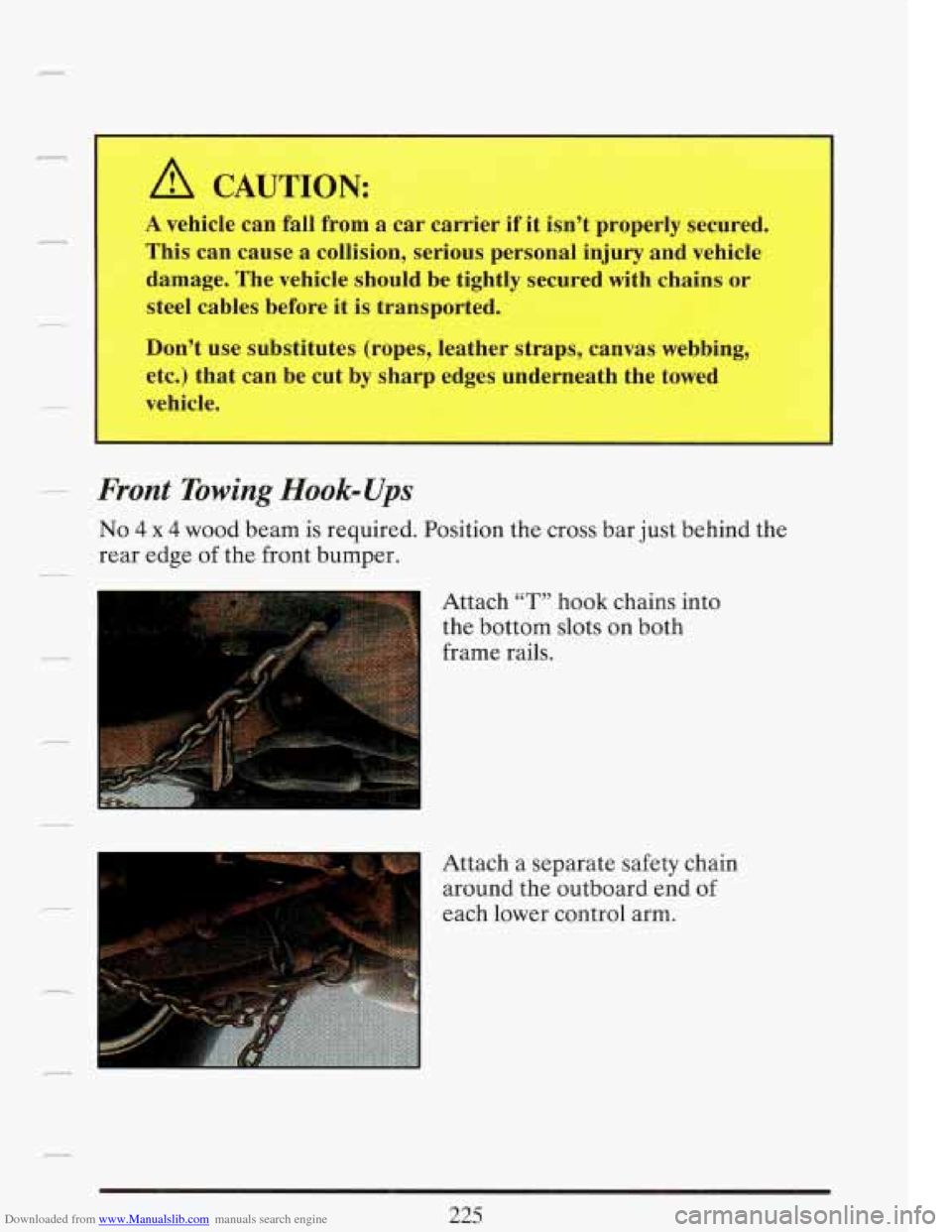
Downloaded from www.Manualslib.com manuals search engine A CAUTION:
A vehicle can fall from a car carrier if it isn’t properly secured.
This can cause
a collision, serious personal injury and vehicle
damage. The vehicle should be tightly secured with chains
or
steel cables before it is transported.
Don’t use substitutes (ropes, leather straps, canvas webbing,
etc.) that can be cut by sharp edges underneath the towed
vehicle.
~ Front Towing Hook-Ups
No 4 x 4 wood beam is required. Position the cross bar just behind the
rear edge of the front bumper.
Attach
“T” hook chains into
the bottom slots on both
frame rails.
I
Attach a separate safety chain
around the outboard end
of
each lower control arm.
225
Page 334 of 386

Downloaded from www.Manualslib.com manuals search engine -' h
Headlights
The headlight wiring is protected by a circuit breaker in the light switch.
An electrical overload will cause the lights to go on and off, or in some
cases to remain off.
If this happens, have your headlight wiring checked
right away.
Windshield Wipers
The windshield wiper motor is protected by a circuit breaker and a fuse.
If the motor overheats due to heavy snow, etc., the wiper will stop until
the motor cools.
If the overload is caused by some electrical problem and
not snow, etc., be sure to get it fixed.
Power Windows and Other Power Options
Circuit breakers in the fuse panel protect the power windows and other
power accessories. When the current load is too heavy, the circuit breaker
opens and closes, protecting the circuit until the problem is fixed or goes
away.
BULB CUT
You can get these from your Cadillac dealer.
DESCRIPTION BULB NO.
Ash Tray Illumination .................................. 1445
Backup Lights
......................................... 2057
Center High Mounted Stop Light
........................ 1141
Cornering Light
....................................... 2057
Courtesy Light
- Front Door ............................ S214-2
Courtesy Light
- Rear Door ............................. S214-2
Courtesy/Map Light
..................................... 192
Front Parking
& Directional Signal .................... 2057NA
Front Side Marker Light
................................. ,194
GloveBox
............................................. 194
Headlight High Beam ...................... 906MB4 (H2990 4)
Headlight Low Beam ....................... 905/HB3 (K1790 3)
License Plate Light
..................................... 194
Parking Light
......................................... 2057
320
Page 368 of 386
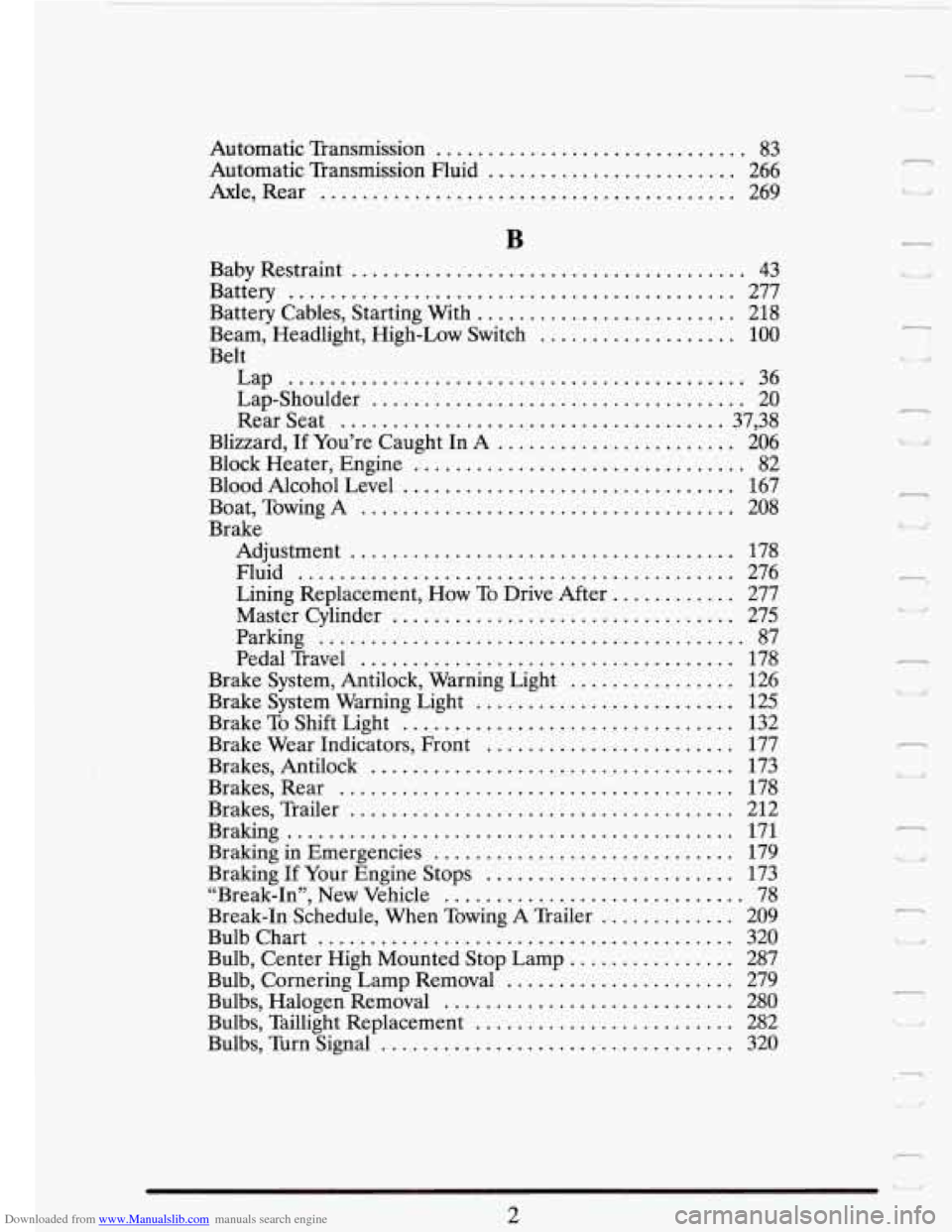
Downloaded from www.Manualslib.com manuals search engine Automatic Transmission .............................. 83
Automatic Transmission Fluid
........................ 266
Axle. Rear ........................................ 269
Baby Restraint
...................................... 43
Battery ........................................... 277
Battery Cables. Starting With
......................... 218
Beam. Headlight. High-Low Switch ................... 100
Belt Lap
............................................. 36
Lap-Shoulder
.................................... 20
Rear Seat
..................................... 37. 38
Blizzard. If You’re Caught In
A ....................... 206
Block Heater. Engine
................................ 82
Blood Alcohol L&el
....
Boat. Towing A ........
Brake
Adjustment
.........
Fluid ..............
Lining. Redacement. H
........................... 167
........................... 208
........................... 178
........................... 276
IW To Drive After ............ 277 . C
Mast& Glinder .................................. 275
Parking
......................................... 87
PedalTravel
.................................... 178
Brake System. Antilock. Warning Light
................ 126
Brake System Warning Light
......................... 125
Brake Wear Indicators. Front
........................ 177
Brakes. Antilock
................................... 173
Brakes. Rear
...................................... 178
Brakes. Trailer
..................................... 212
Braking
........................................... 171
Braking in Emergencies ............................. 179
Braking If Your Engine Stops ........................ 173
“Break.111”. New Vehicle
............................. 78
Break-In Schedule. When Towing
A Trailer ............. 209
Bulb Chart
........................................ 320
Bulb. Center High Mounted Stop Lamp
................ 287
Bulb. Cornering Lamp Removal
...................... 279
Bulbs. Halogen Removal
............................ 280
Brake
To Shift Light
................................ 132
Bulbs. Taillight Replacement
......................... 282
Bulbs. Turn Signal
.................................. 320
rnl
. 3 I
-4
e
1
1
..